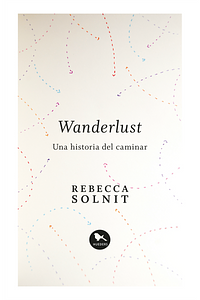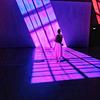Take a photo of a barcode or cover
This will be the first book discussed for walking book club.
At some point this year, Rebecca Solnit's name and books came to my attention. I wish I could remember how or why this happened. All that really matters is that I gotten to read some fascinating books. This is my second, No Ordinary Land by Laura McPhee included an essay by Solnit.
Microhistories, detailed books about one subject have probably existed for a long time, but the genre has grown like crazy in the last decade. Who knew that a whole book on salt, pencils, turquoise or walking could be so interesting. Solnit has written an excellent example of narrative non-fiction.
Solnit did her research and seems to have covered walking as throughly as one could. This is not a dry book. Solnit covers walking from pilgrimages to hiking through the streets of cities to suburbia, and her thoughts and excellent writing makes the journey very enjoyable.
In an interview, Solnit is asked to define herself as a type of author. She is unwilling to define herself as a particular kind of writer. She says, "I realized there that the genres — first-person lyrical essay, reportage, critical analysis — couldn’t be separate, that I needed all the tools..." in this case when she was writing about the Nevada test site. I think this is why I like Solnit's writing. She uses what she needs to tell her story. I am grateful that Solnit does not have one field that she writes about, but applies her knowledge to what she encounters. I look forward to meandering with Solnit again soon.
I recommend this book to readers who like to learn, who find books as a way to travel to new places and encounter different viewpoints.
Microhistories, detailed books about one subject have probably existed for a long time, but the genre has grown like crazy in the last decade. Who knew that a whole book on salt, pencils, turquoise or walking could be so interesting. Solnit has written an excellent example of narrative non-fiction.
Solnit did her research and seems to have covered walking as throughly as one could. This is not a dry book. Solnit covers walking from pilgrimages to hiking through the streets of cities to suburbia, and her thoughts and excellent writing makes the journey very enjoyable.
In an interview, Solnit is asked to define herself as a type of author. She is unwilling to define herself as a particular kind of writer. She says, "I realized there that the genres — first-person lyrical essay, reportage, critical analysis — couldn’t be separate, that I needed all the tools..." in this case when she was writing about the Nevada test site. I think this is why I like Solnit's writing. She uses what she needs to tell her story. I am grateful that Solnit does not have one field that she writes about, but applies her knowledge to what she encounters. I look forward to meandering with Solnit again soon.
I recommend this book to readers who like to learn, who find books as a way to travel to new places and encounter different viewpoints.
Generally I really like Rebecca Solnit’s writing. The first 70% or so of this book, however, was a real slog for me. But I did quite enjoy the last 4 chapters-on gendered issues, suburbia (and exercise and bodies and consumption), art, and, surprisingly, Las Vegas (and commercialism, facades, nature, and space).
adventurous
informative
inspiring
lighthearted
reflective
slow-paced
Incredible
informative
reflective
slow-paced
Death to treadmills, but not to this book, it’s a really good book
hopeful
inspiring
reflective
medium-paced
challenging
hopeful
informative
inspiring
reflective
slow-paced
Blending activism with memoir and history with biology, 'Wanderlust' is a powerful and informative read. Rebecca Solnit is a thorough writer. With confident prose always backed with interesting and appropriate case studies, she leads the reader through her chapters like a guide who leaves no stone is unturned.
We begin with the birth of bipedalism. Humans stood up so they could cover more land, travel farther yet this natural shift is contrasted by a technological shift in the final chapter about Las Vegas. The suggestion that our postures are changing once more is very sad. Our bodies are changing because we are being forced inside by the privatisation of public space. Forced inside by the zoom paced world of technology, that makes us feel like we need things fast and instant.
I can't ignore the fact that I read this book during the COVID 19 quarantine. It gave me an interesting perspective on each and every chapter. I was not reading from a place of freedom. I was reading from a deprived place. I wasn't walking as much and I'm avid at the walking thing. I live for it that's why picked up this book. Walking during lockdown is a whole different matter especially in countries like Italy and Spain who weren't allowed outside to exercise for a number of weeks. However, this book highlights how the natural essence of walking is taken for granted. We could do better, but we are getting distracted by the bright neon lights of our options.
My favourite chapter: 'Walking After Midnight' discussed the female body in terms of walking and public space. The history of walking is the history of female oppression. But as Solnit states, "the world gets better, the same time it gets worse." We make such progress only to make none at all. 'Wanderlust' evaluates difficult subjects with a sensitive precision. It is not a bleak read. It is empowering. If your body is able, walking is the very celebration of what it is to be human. In it's raw and natural sense. To rise on to two legs was a celebration of the body, its strength. but to sit in a car, then a train, then a plane. That is the celebration of the mind and the limitless nature of its progressions.
I will end with one of the many beautiful quotes Solnit used to chronicle what walking is. That she likens it to a constellation highlights the beauty of our paths and traces.
"Walking has been one of the constellations in the starry sky of human culture, a constellation whose three stars are the body, the imagination, and the wide open world, and through all three exists independently, it is lines drawn by the act of walking for cultural purposes- that makes them a constellation."
We begin with the birth of bipedalism. Humans stood up so they could cover more land, travel farther yet this natural shift is contrasted by a technological shift in the final chapter about Las Vegas. The suggestion that our postures are changing once more is very sad. Our bodies are changing because we are being forced inside by the privatisation of public space. Forced inside by the zoom paced world of technology, that makes us feel like we need things fast and instant.
I can't ignore the fact that I read this book during the COVID 19 quarantine. It gave me an interesting perspective on each and every chapter. I was not reading from a place of freedom. I was reading from a deprived place. I wasn't walking as much and I'm avid at the walking thing. I live for it that's why picked up this book. Walking during lockdown is a whole different matter especially in countries like Italy and Spain who weren't allowed outside to exercise for a number of weeks. However, this book highlights how the natural essence of walking is taken for granted. We could do better, but we are getting distracted by the bright neon lights of our options.
My favourite chapter: 'Walking After Midnight' discussed the female body in terms of walking and public space. The history of walking is the history of female oppression. But as Solnit states, "the world gets better, the same time it gets worse." We make such progress only to make none at all. 'Wanderlust' evaluates difficult subjects with a sensitive precision. It is not a bleak read. It is empowering. If your body is able, walking is the very celebration of what it is to be human. In it's raw and natural sense. To rise on to two legs was a celebration of the body, its strength. but to sit in a car, then a train, then a plane. That is the celebration of the mind and the limitless nature of its progressions.
I will end with one of the many beautiful quotes Solnit used to chronicle what walking is. That she likens it to a constellation highlights the beauty of our paths and traces.
"Walking has been one of the constellations in the starry sky of human culture, a constellation whose three stars are the body, the imagination, and the wide open world, and through all three exists independently, it is lines drawn by the act of walking for cultural purposes- that makes them a constellation."
reflective
slow-paced



